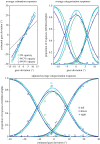How wide is the cone of direct gaze?
- PMID: 30225015
- PMCID: PMC6124122
- DOI: 10.1098/rsos.180249
How wide is the cone of direct gaze?
Abstract
The cone of direct gaze refers to the range of gaze deviations an observer accepts as looking directly at them. Previous experiments have calculated the width of the cone of direct gaze using the gaze deviations actually presented to the observer, however, there is considerable evidence that observers actually perceive gaze to be systematically more deviated than actually presented. Here, we examine the width of the cone of direct gaze in units of perceived gaze deviation. In doing so, we are able to disambiguate differences in width both within and between observers that are due to differences in their perception of gaze and due to differences in what observers consider to be looking at them. We suggest that this line of inquiry can offer further insight into the perception of gaze direction, and how this perception may differ in clinical populations.
Keywords: gaze perception; person perception; social cognition.
Conflict of interest statement
We have no competing interests.
Figures






References
Associated data
LinkOut - more resources
Full Text Sources
Other Literature Sources

